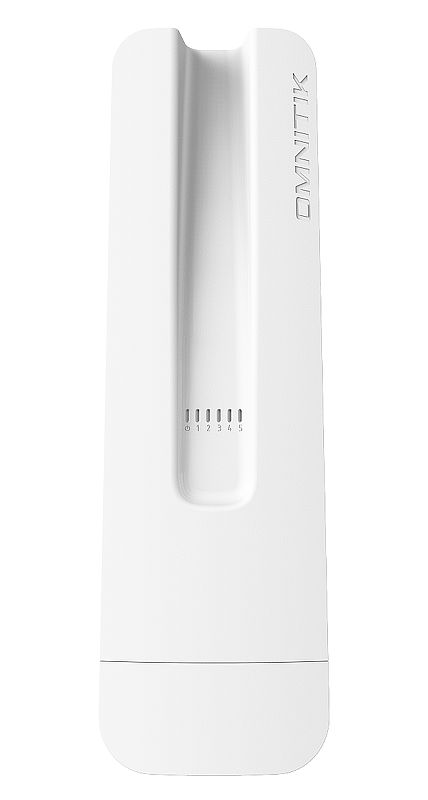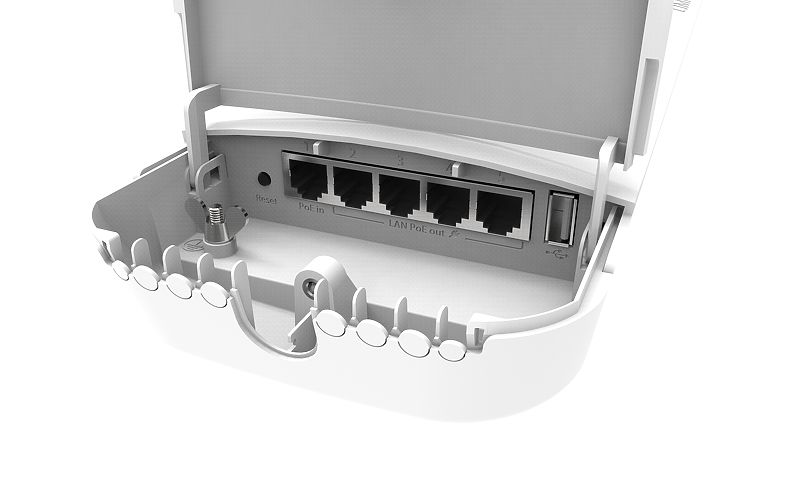MikroTik OmniTik 5 POE ac
The Omnitik 5ac is an outdoor switch/router with a built-in 5Ghz 802.11ac access point, omnidirectional antenna, and 5 gigabit ethernet ports. Be sure to get the POE version. Here are the config instructions
The OmniTik serves a few purposes for us. We can plug in other devices such as a LiteBeam, or run cables down to apartments. It acts as an AP for the rooftop, and also runs our config of WDS and OSPF so it will mesh with other OmniTiks or SXTsqs within a few blocks
Please be sure to see MikroTik Specifics for extra info about Mikrotik devices, how to connect, etc.


The PoE version accepts 12-57V passive PoE on port 1 and can be configured to provide PoE out to ports 2-5.


The small round plastic tabs, shown in the picture above, should be removed for those cable ports you will use - push them firmly inwards to remove. Leave the tabs in unused ports to prevent water entry.
Device specs are available at Mikrotik.com
Uses
- Hub node routing or AP ( for standard 802.11ac hubs )
- Rooftop installations for multi-tenant houses
- Providing public access via the omnidirectional antenna
How to reset
- Press reset
- Apply power
- Watch the power led, once it blinks, STOP pressing the reset button
- It will beep one time
- Once you hear two beeps, you should be able to access it.
How to upgrade the firmware
- Upload the routeros-mipsbe-x.x.x.npk file in http://192.168.88.1/webfig/#Files
- Select System Reboot
How to downgrade firmware
- Upload the routeros-mipsbe-x.x.x.npk file in http://192.168.88.1/webfig/#Files
- Go to Terminal and type
/system package downgrade;
Configurations
Omnitik config
Here are the current config instructions. As discussed in the MikroTik Specifics page, these devices need a script to be generated and loaded onto the device rather than a saved config file.
We now have a script generator you can find here https://configgen.nycmesh.net/
Here is a slideshow of configuring an OmniTik
Expand for `OLD nycmesh-omnitik-v3.2.rsc` example
The is our obsolete 3.2 template script which needs some variables filled in.
This script only works on the OmniTik 5ac PoE model
Version 3.2 Changelog:
- Separation of Public vs Tenant subnet
- Fixed BGP sync missed config parameter
- Startup delay ( ref Mikrotik forums )
- Tada sound effect
- Better firewall rules
:global nodenumber 1111
:global bgpasn 61111
:global ipprefix "10.70.111"
:global iptenantsrange 10.70.111.5-10.70.111.119
:global iptenantsgw 10.70.111.1
:global ippublicrange 10.70.111.130-10.70.111.180
:global ippublicgw 10.70.111.129
:global dns 10.10.10.10,1.1.1.1
/delay 15
:for j from=1 to=4 step=1 do={
:for i from=2000 to=50 step=-400 do={
:beep frequency=$i length=11ms;
:delay 11ms;
}
:for i from=800 to=2000 step=400 do={
:beep frequency=$i length=11ms;
:delay 11ms;
}
}
:foreach x in=[/interface wireless find] do={ /interface wireless reset-configuration $x }
:for t from=1200 to=350 step=-50 do={
:beep frequency=$t length=33ms;
:delay 33ms;
}
:beep frequency=500 length=100ms
/ip address add address=192.168.88.1/24 interface=ether3 network=192.168.88.0
:beep frequency=600 length=100ms
/interface ethernet
set [ find default-name=ether5 ] poe-out=forced-on
:beep frequency=700 length=100ms
/interface wireless security-profiles
add authentication-types=wpa-psk,wpa2-psk management-protection=allowed mode=\
dynamic-keys name=nycmeshnet supplicant-identity=nycmesh \
wpa-pre-shared-key=nycmeshnet wpa2-pre-shared-key=nycmeshnet
:beep frequency=800 length=100ms
/interface wireless
set [ find default-name=wlan1 ] band=5ghz-a/n/ac channel-width=20/40/80mhz-Ceee disabled=no distance=indoors frequency=auto mode=ap-bridge security-profile=nycmeshnet ssid=("nycmesh-" . $nodenumber . "-omni") wireless-protocol=802.11 wps-mode=disabled
add disabled=no master-interface=wlan1 name=wlan2 ssid="-NYC Mesh Community WiFi-" wps-mode=disabled
:beep frequency=900 length=100ms
/interface bridge
add auto-mac=yes name=publicaccess
add auto-mac=yes name=tenants
:beep frequency=1000 length=100ms
/ip address
add address=($ipprefix . ".1/25") interface=tenants network=($ipprefix . ".0")
add address=($ipprefix . ".129/26") interface=publicaccess network=($ipprefix . ".128")
:beep frequency=1100 length=100ms
/interface bridge port
add bridge=tenants interface=ether1
add bridge=tenants interface=ether2
add bridge=tenants interface=ether3
add bridge=tenants interface=ether4
add bridge=tenants interface=wlan1
add bridge=publicaccess interface=wlan2
:beep frequency=1200 length=100ms
/ip pool
add name=tenants ranges=$iptenantsrange
add name=publicaccess ranges=$ippublicrange
:beep frequency=1300 length=100ms
/ip dhcp-server
add address-pool=tenants disabled=no interface=tenants name=tenantsdhcp
add address-pool=publicaccess disabled=no interface=publicaccess name=publicaccessdhcp
:beep frequency=1400 length=100ms
/routing bgp instance
set default as=$bgpasn disabled=no
:beep frequency=1500 length=100ms
/routing bgp network
add network=($ipprefix . ".0/24") synchronize=no
:beep frequency=1600 length=100ms
/ip dhcp-server network
add address=($ipprefix . ".0/25") dns-server=10.10.10.10 gateway=($ipprefix . ".1") netmask=25
add address=($ipprefix . ".128/26") dns-server=10.10.10.10 gateway=($ipprefix . ".129") netmask=25
:beep frequency=1700 length=100ms
/ip firewall filter
add action=accept chain=input protocol=icmp
add action=drop chain=forward in-interface=publicaccess out-interface=tenants
add action=drop chain=input in-interface=publicaccess
add action=accept chain=forward
add action=accept chain=input
:beep frequency=1800 length=100ms
/system clock set time-zone-name=America/New_York
/system identity set name=("nycmesh-" . $nodenumber . "-omni")
:beep frequency=500 length=200ms;
:delay 500ms;
:beep frequency=500 length=200ms;
:delay 200ms;
:beep frequency=800 length=500ms;
:delay 50ms;
How to apply config:
- Acquire config parameters ( BGP ASN, IP range, node number, etc. )
- Fill in config file parameters at the top of the script.
.rscat the end.
- Factory Reset device if needed ( see MikroTik Specifics for details )
- Update firmware to latest on your device ( see Mikrotik Firmware )
- Upload the rsc file
- The file needs to be in the
flash/folder. However, there is no way to create a folder from the device. - Instead you need to upload the file using scp.
- From a Mac or Linux desktop, upload the file using scp:
scp nycmesh-omni-####.rsc admin@192.168.88.1:flash/ - From a Windows desktop, you must have PuTTY installed and run the following command from the command prompt:
pscp -scp nycmesh-omni-####.rsc admin@192.168.88.1:flash/ - You should see the file in the WebUI as
flash/nycmesh-omni-####.rsc
- The file needs to be in the
- Factory Reset the device with the option to restore this script.
- From Web UI:
- WebFig > System > Reset Configuration. Select:
- No Defaults
- Run After Reset:
flash/nycmesh-omni-####.rsc - Apply
- Or from CLI:
/system reset-configuration run-after-reset=flash/nycmesh-omni-####.rsc no-defaults=yes- Dangerous Reset anyway? Y
- From Web UI:
